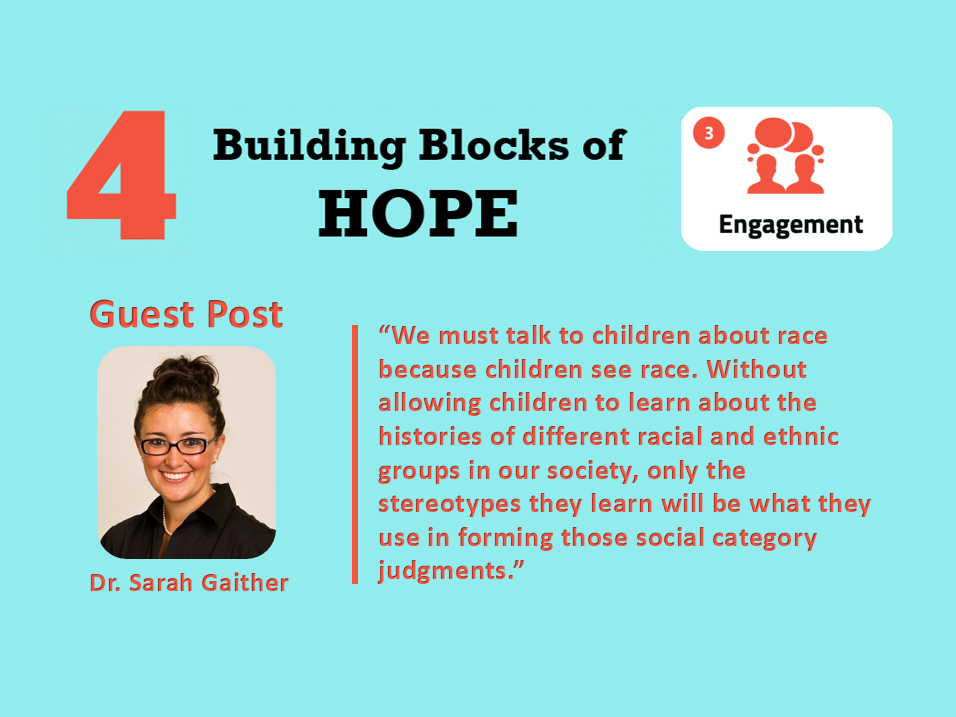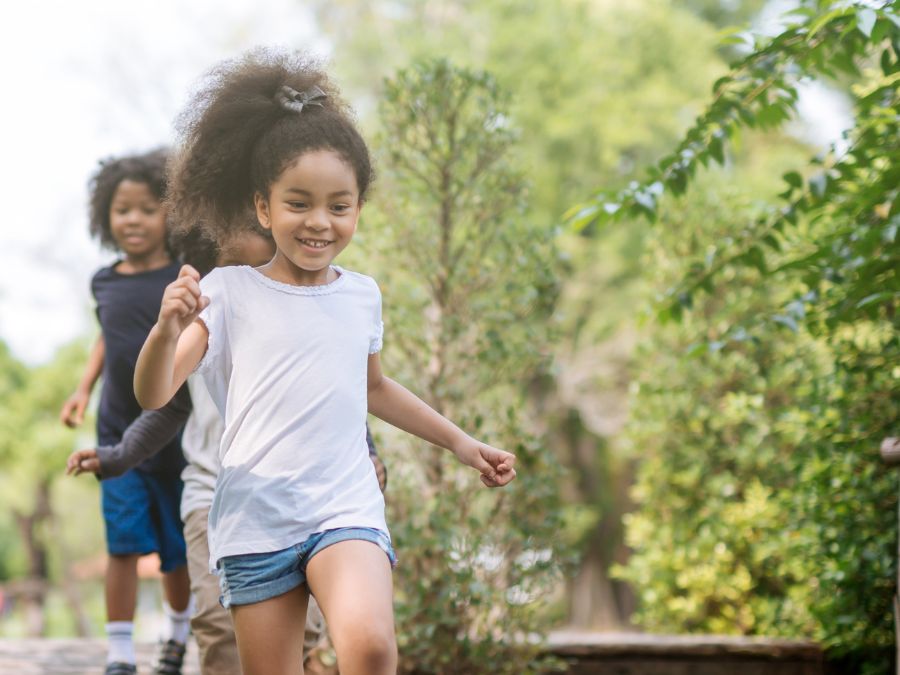
From the recent murders of George Floyd, Breonna Taylor, and countless other Black Americans throughout history, whose lives were taken by police brutality and systemic racism, we have seen how dismantling all forms of racism is critical to the central mission of HOPE: ensuring healthy, equitable child development for all, regardless of race. Systemic solutions, structures of accountability, and addressing individual biases are all necessary steps toward this goal. In this post, we ask how parents can educate their children on racism, and how those conversations contribute to child development and community engagement.
To answer these questions, we turn to Dr. Sarah Gaither, an Assistant Professor in the Department of Psychology & Neuroscience and a faculty affiliate at the Cook Center on Social Equity at Duke University. Dr. Gaither is Principal Investigator of the Duke Identity and Diversity Lab, and she can be found on Twitter @sarahegaither. She is a Tufts alum, PhD class of 2014.
Many parents want to help their children understand race and racism and wonder when to start the conversation. How old are children when they first become aware of race? Why is it essential to speak candidly to children about race instead of promoting “colorblindness” or shying away from the topic?
By three months of age, infants growing up in racially homogeneous environments (in other words, less diverse environments) already distinguish faces from their own racial group better than other racial groups. By preschool, children may have already learned strong in-group biases, meaning they think people who look like them are better than people who look differently. Additionally, the classic Clark and Clark doll study has been replicated since its original findings from the 1940’s, highlighting that both White and Black children show a pro-White bias with White dolls being seen as smarter, prettier, and better than Black dolls. However, children who are exposed to more diversity also tend to be less fixed in how they think about different social groups, suggesting the power that exposure to people who are different in positive ways can have over our social perceptions. Therefore, we must talk to children about race because children see race. Without allowing children to learn about the histories of different racial and ethnic groups in our society, only the stereotypes they learn will be what they use in forming those social category judgments. Therefore, promoting a colorblindness approach will only further promote the wrongful applications of stereotypes.
Can you expand on how children’s conceptions of race develop?
We all want to maintain a positive view of ourselves since that maintains our self-esteem. Similarly, children learn a positive in-group bias early on in childhood as a part of this positive identity maintenance. This constant comparison of considering whether someone is your in-group versus your out-group is called intergroup relations in psychology, and children are very good at visually categorizing anyone they see around them. This same process is used to form both love and hate for the different people around us. And what psychology research would argue is that without positive exposure to people who are different from ourselves, we become polarized, which can lead to extreme in-group favoritism and out-group hate.
How can parents talk to children about race in a way that encourages them not only to be not racist, but anti-racist? How does this contribute to children’s environments?
It is one thing to teach a child not to be racist, but an entirely other thing to teach a child to be an anti-racist. The difference lies in a child’s willingness to speak up against an act of discrimination. Teaching children to be able to recognize and confront discrimination has been shown in past research to positively shift a school’s climate and decrease rates of stereotyping within a classroom setting. Using examples of how a person’s skin color may lead to different treatment is another good way to get children to perspective-take about how their life might be different if they had differently colored skin. Giving children explicit phrases to use when they see discrimination can help make a whole environment safer and more inclusive for underrepresented students. Simple phrases such as, “I don’t think what you said or did is fair,” can help children learn to be a true ally.
For parents who want to talk about race and ethnicity with their children but don’t know how to go about doing so, what insight would you offer?
There are tons of resources available to parents online, including videos, home activities, podcasts, and lesson plans that can give parents tools to use in starting these discussions. Teachingtolerance.org is a great resource with lots of advice for teachers and parents. Socialjusticebooks.org is a great website where you can search for books that are age appropriate for your child. Sesame Street with CNN also did a great virtual town hall recently which, for younger children, is a nice starting point for how to talk about Black Lives Matter, including the protests and various emotions and reactions children may see from the media.
I also would advise people who have not talked about race with their kids that much before to start small. Maybe read a new book to a child that features a diverse set of characters that you can use as a discussion tool. Or find a positive television show or movie that features a minority lead character to give your child extra exposure and a chance for you as a parent to sit and engage with your child while watching the show together. You have to find comfort in your discomfort, since children will read your signals during those discussions. Starting small and working your way up to the more difficult conversations, can help build confidence for parents starting these conversations for the first time.
How can talking about race with children be a positive thing instead of something to avoid, and how can such conversations promote positive development? How can talking about race with children promote positive engagement with their community?
Being able to perspective-take effectively is associated in psychology research with being more creative and being a better problem solver. Therefore, talking about race with children can increase a child’s ability to practice racial empathy, which in turn can allow a child to be more helpful to other children in the future, when they may see an act of prejudice or discrimination. In fact, being prosocial or helping others psychology argues is one of the best ways to sustain your happiness or positive mood. So giving children the tools to help others across racial and ethnic group lines can not only make the world a happier place, but that individual child speaking up may also be happier too.


